A Bayesian Equal Part Regression Analysis of the Influencing Factors of Taiwanese People’s Regime Acceptance of Mainland China and U.S. Governments
Abstract
:1. Introduction
2. Literature Review
2.1. Regime Acceptance
2.1.1. Taiwanese People’s Regime Acceptance of Mainland China
- (1)
- Social identity: In regard to identity development and change, the Taiwanese people’s identity relates to their social identity, which indicates the social groups to which they belong [6]. According to ethnic identity, Taiwanese people can be classified into three political identity groups, Taiwanese, Chinese, and dual identity. Ethnic identity may affect the Taiwanese people’s political views on unification and other policy preferences. As far as Taiwanese people’s regime acceptance of China is concerned, the political identity issue becomes more intertwined with domestic politics. The political identity issues, such as the degree to which Taiwanese people think of themselves as Taiwanese, Chinese, or both, affects the formulation of Taiwan’s cross-strait policies, economic policies, and social policies [7].
- (2)
- Rational choice: Rational choice theory implies that people can make choices according to their preferences [8]. Taiwanese people’s regime acceptance of China is also based on self-interest. Taiwanese people’s business interests and career paths have a very close relationship with China, and this affects Taiwanese people’s attitude toward China. This means that Taiwanese people’s regime acceptance of Mainland China is also influenced by economic issues. Keng and Schubert also consider that Mainland China used economic incentives as a tool to influence Taiwan’s regime acceptance [9].
- (3)
- Social contact: Social contact theory means that various personal interactions in a group affect the attitudes and behaviors of the group members and individual differences and societal norms construct intergroup contact effects [10]. The regime acceptance of Taiwanese people who do not have close interactions with Mainland China would be influenced by their engrained impression of Mainland China’s political system. Since Taiwan has been regarded as a democratic and free political entity compared with Mainland China’s political system, Taiwanese people have a negative impression of Mainland China’s political system, which would affect Taiwanese people’s regime acceptance of China. Li argues that the different political systems between Mainland China and Taiwan have a significant impact on the social experiences formulation [11]. The difference of political systems also affects the change of nationalism and identities, which would influence the future of cross-strait relations. Lin and Hsieh [12] deem that the Taiwanese people’s public discontent with Mainland China already exists and would aggravate the uncertainty of cross-strait relations.
- (4)
- Political socialization: Political socialization is the process by which political culture can be transferred from one generation to the next [13]. There are four major political socialization agents, including family, school, peer group, and mass communication media. Taiwanese people’s regime acceptance of China can be formulated and affected by these agents. The younger generation in Taiwan, which is different from the older generation, is becoming hostile to Mainland China. This phenomenon aggravates cross-strait relations and resulted in the sabotage of cross-strait trade talks in 2014 [14].
2.1.2. Taiwanese People’s Regime Acceptance of the U.S.
- (1)
- Rational choice: Taiwanese people’s regime acceptance of the U.S. is also based on self-interest. Some Taiwanese people believe the U.S. government would protect Taiwan in the event of Mainland China’s invasion. According to the Taiwan National Security Survey in 2011, 56.4% of respondents said the U.S. would defend Taiwan against Chinese invasion, and 73.5% if Taiwan maintains the status quo but faces an attack by China [17]. This result reflects some Taiwanese people’s positive views of the U.S. They think that they can count on the U.S. for Taiwan’s security issues.
- (2)
- Social contact: The Taiwanese people who do not have close interactions with the U.S. would be influenced by their engrained impression of the U.S. political and economic system. The survey by Gries and Su also indicated that the U.S. was ranked as the fifth most admired country, following Germany, Australia, the UK, and France, by Taiwanese people [18]. Their survey focused on the survey respondents’ personal impression on these countries. It implied that these advanced economics, including the U.S., were admired by Taiwanese people.
- (3)
- Political socialization: The popular culture transmitted by the mass media affects young people’s political participation and their political identity, which belong to the characteristics of the political socialization [19]. Taiwanese people’s regime acceptance of the U.S. is also influenced by political socialization. According to the survey by Gries and Su, the popular culture of the U.S. and Japan were the most admired by the Taiwanese people [18]. The engrained popular culture would affect Taiwanese people’s evaluation of the U.S.
3. Methodology
3.1. Equal Part Linear Regression
3.2. Bayesian Equal Part Linear Regression
3.3. Research Design
3.4. Data Description
- Whether the Taiwanese respondents agree with the viewpoint that Mainland China would coerce Taiwan to make more political concessions in the case of more economic dependence (nQ4). The minimum value (strongly disapprove) is 1, and the maximum value (strongly approve) is 4.
- Whether the Taiwanese respondents support the declaration of Taiwanese independence in the case of Mainland China’s attack after the announcement of independence (nQ13). The minimum value (strongly disagree) is 1, and the maximum value (strongly agree) is 4.
- Whether the Taiwanese respondents agree with the unification with Mainland China in the case of a smaller gap in their societies, political systems and economic systems (nQ16). The minimum value (strongly disagree) is 1, and the maximum value (strongly agree) is 4.
- The question nQ18 is the Taiwanese respondents’ evaluation of the possibility of unification. The minimum value is 0 and the maximum value is 10.
- The question nQ25 is the Taiwanese respondents’ evaluation of cross-strait (Mainland China and Taiwan) relations. The minimum value 0 means that they feel the cross-strait relations hostile and the maximum value 10 means they feel the cross-strait relations peaceful.
- Question nQ6 asks the respondents about the future prospect evaluation of their household economic conditions one year later. The minimum value is 1 (worse) and the maximum value is 2 (the same as the present).
- Question nQ18 asks the respondents about the evaluation of the possibility of unification. The minimum value is 0, and the maximum value is 10.
- Whether Taiwanese respondents agree that the Taiwanese government should reduce the amount of its military weaponry and equipment if Mainland China withdraws its missiles from its southeast coastline (nQ21). The minimum value is 1 (strongly disagree) and the maximum value is 4 (strongly agree).
- Question nQ25 asks the respondents about their evaluation of current cross-strait relations. The minimum value (very hostile) is 0, and the maximum value (very peaceful) is 10.
- Question nQ27 asks the respondents about their evaluation of the possibility of the military actions in case of Taiwan’s unilateral declaration of independence. The minimum value is 1 (impossible) and the maximum value is 4 (very possible).
- Question nQ29 asks the respondents whether most Taiwanese people would fight back in case of Chinese military actions resulting from Taiwan’s unilateral declaration of independence. The minimum value is 1 (impossible) and the maximum value is 4 (very possible).
- Question nQ31 asks the respondents about the viewpoint that Taiwan is an independent country with sovereignty and its current country name is Republic of China (R.O.C) and it is unnecessary to declare for independence. The minimum value is 1 (strongly disagree) and the maximum value is 4 (strongly agree).
4. Results and Discussion
4.1. BEPR Model 1
4.2. BEPR Model 2
4.3. Discussion
5. Conclusions
Funding
Conflicts of Interest
References
- Gordon, M.M. Assimilation in American Life: The Role of Race, Religion, and National Origins; Oxford University Press: New York, NY, USA, 1964; pp. 70–71. [Google Scholar]
- Wang, C.C. Primordialism, Instrumentalism, Constructivism: Factors Influencing Taiwanese People’s Regime Acceptance of Mainland China’s Government. J. Contemp. China 2018, 27, 137–150. [Google Scholar] [CrossRef]
- Lin, C.M.; Chou, C.C.; Kuang, C.C. The security Situation in the Taiwan Strait: An Analysis from Security Dilemma. Lang. Int. Stud. Chin. 2015, 13, 105–129. [Google Scholar]
- Tzeng, W.F.; Lee, K.C.; Macaulay, C. Why Is China Unwelcome in Taiwan? Cultural Alienation, Democratic Anxiety or Economic Loss in Explaining Taiwanese Resistance to China. Issues Stud. 2017, 53, 1750011. [Google Scholar] [CrossRef]
- Feklyunina, V. Soft power and identity: Russia, Ukraine and the ‘Russian world(s)’. Eur. J. Int. Relat. 2016, 22, 773–796. [Google Scholar] [CrossRef]
- Zhong, Y. Explaining national identity shift in Taiwan. J. Contemp. China 2016, 25, 336–352. [Google Scholar] [CrossRef]
- Cabestan, J.P.; DeLisle, J. Political Changes in Taiwan under Ma Ying-jeou: Partisan Conflict, Policy Choices, External Constraints and Security Challenges; Routledge: New York, NY, USA, 2014. [Google Scholar]
- Green, D.P.; Fox, J. Rational choice theory. Social Science Methodology; Sage Publications: London, UK, 2007; pp. 269–281. [Google Scholar]
- Keng, S.; Schubert, G. Agents of Taiwan-China unification? The political roles of Taiwanese business people in the process of cross-strait integration. Asian Surv. 2010, 50, 287–310. [Google Scholar] [CrossRef]
- Pettingrew, T.F. Intergroup Contact Theory. Annu. Rev. Psychol. 1998, 49, 65–85. [Google Scholar] [CrossRef] [PubMed]
- Li, Y. Constructing peace in the Taiwan Strait: A Constructivist Analysis of the Changing Dynamics of Identities and Nationalisms. J. Contemp. China 2014, 23, 119–142. [Google Scholar] [CrossRef]
- Lin, Y.; Hsieh, J.F.S. Change and Continuity in Taiwan’s Public Opinion on the Cross-Strait Economic Interactions. J. Asian Afr. Stud. 2017, 52, 1103–1116. [Google Scholar] [CrossRef]
- Langton, K. Political Socialization; Oxford University Press: New York, NY, USA, 1969; p. 4. [Google Scholar]
- Liu, F.C.S.; Li, Y. Generation matters: Taiwan’s perceptions of Mainland China and Attitudes towards Cross-Strait Trade Talks. J. Contemp. China 2017, 26, 263–279. [Google Scholar] [CrossRef]
- Chen, D.P. US Strategic Ambiguity, Rising China, and Taiwan’s Security. In US-China Rivalry and Taiwan’s Mainland Policy; Palgrave Macmillan: Cham, Switzerland, 2017; pp. 137–171. [Google Scholar]
- Roy, D. Prospects for Taiwan Maintaining Its Autonomy under Chinese Pressure. Asian Surv. 2017, 57, 1135–1158. [Google Scholar] [CrossRef]
- Wang, Y.K. Taiwan Public Opinion on Cross-Strait Security Issues: Implications for US Foreign Policy. Strateg. Stud. Q. 2013, 7, 93–113. [Google Scholar]
- Gries, P.H.; Su, J. Taiwanese views of China and the world: Party identification, ethnicity, and cross–strait relations. Jpn. J. Political Sci. 2013, 14, 73–96. [Google Scholar] [CrossRef]
- Loader, B.D.; Vromen, A.; Xenos, M.A. The networked young citizen: Social media, political participation and civic engagement. Inf. Commun. Soc. 2014, 17, 143–150. [Google Scholar] [CrossRef]
- Pan, W.T. A Newer Equal Part Linear Regression Model: A Case Study of the Influence of Educational Input on Gross National Income. Eurasia J. Math. Sci. Technol. Educ. 2017, 13, 5765–5773. [Google Scholar] [CrossRef] [Green Version]
- Koenker, R.W.; Basset, G. Regression Quantile. Econometrica 1978, 46, 33–50. [Google Scholar] [CrossRef]
- Pan, W.T.; Leu, Y. An analysis of bank service satisfaction based on quantile regression and grey relational analysis. Math. Probl. Eng. 2016. [Google Scholar] [CrossRef]
- Zhong, Z.C.; Chen, X.Y.; Yang, H.L.; Wang, G.; Pan, W.T. Theoretical and Case Study on Multiple Equal Part Linear Regression. In DEStech Transactions on Computer Science and Engineering (CMSAM), Proceedings of the 2017 2nd International Conference on Computational Modeling, Simulation and Applied Mathematics (CMSAM 2017), Beijing, China, 22–23 October 2017; DEStech Publications: Toronto, ON, Canada, 2017. [Google Scholar] [Green Version]
- Agliari, A.; Parisetti, C.C. A-G Reference Informative Prior: A Note on Zellner’s G-Prior. J. R. Stat. Soc. Ser. D Stat. 1988, 37, 271–275. [Google Scholar] [CrossRef]
- Merlise, C. Bayesian Variable Selection and Model Averaging Using Bayesian Adaptive Sampling; R package version 1.5.3. 2018. Available online: https://rdrr.io/cran/BAS/ (accessed on 15 April 2019).
- Garcia-Donato, G.; Forte, A. BayesVarSel: Bayes Factors, Model Choice and Variable Selection in Linear Models, R package version 1.8.0.; 2017. Available online: https://CRAN.R-project.org/package=BayesVarSel (accessed on 29 May 2019).
- O’Hara, R.B.; Sillanpää, M.J. A review of Bayesian variable selection methods: What, how and which. Bayesian Anal. 2009, 4, 85–117. [Google Scholar] [CrossRef]
- Cabestan, J.P. Cross-Strait integration and Taiwan’s new security challenges. In Taiwan and The China Impact; Routledge: New York, NY, USA, 2015; pp. 300–318. [Google Scholar]
- Omata, Y.; Katayama, H.; Arimura, T.H. Same concerns, same responses? A Bayesian quantile regression analysis of the determinants for supporting nuclear power generation in Japan. Environ. Econ. Policy Stud. 2017, 19, 581–608. [Google Scholar] [CrossRef]
- Wu, S.; Guo, J. The Bayesian quantile regression and rough set classification: Taiwanese satisfaction level analysis. Kybernetes 2017, 46, 1262–1274. [Google Scholar] [CrossRef]
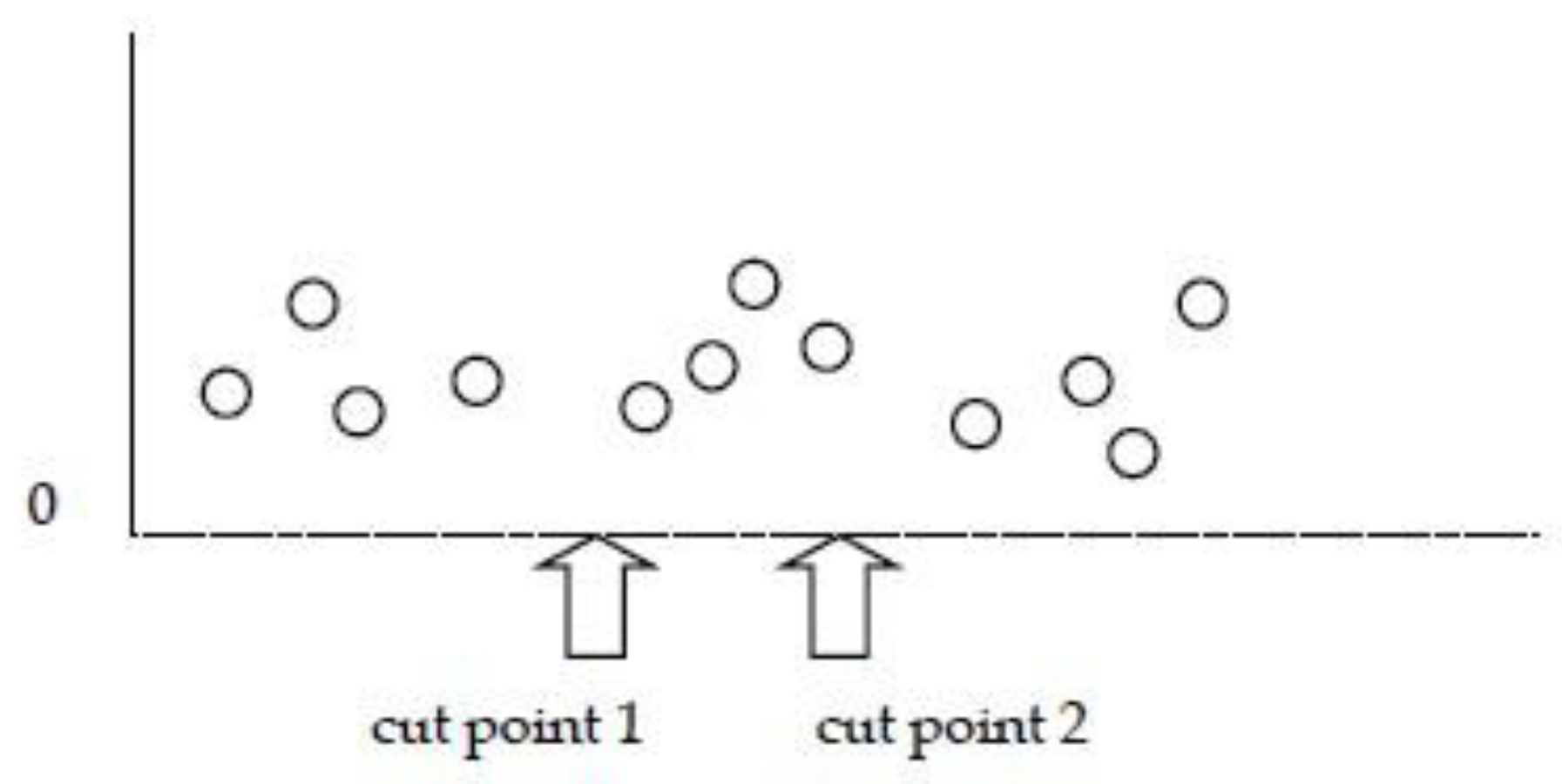
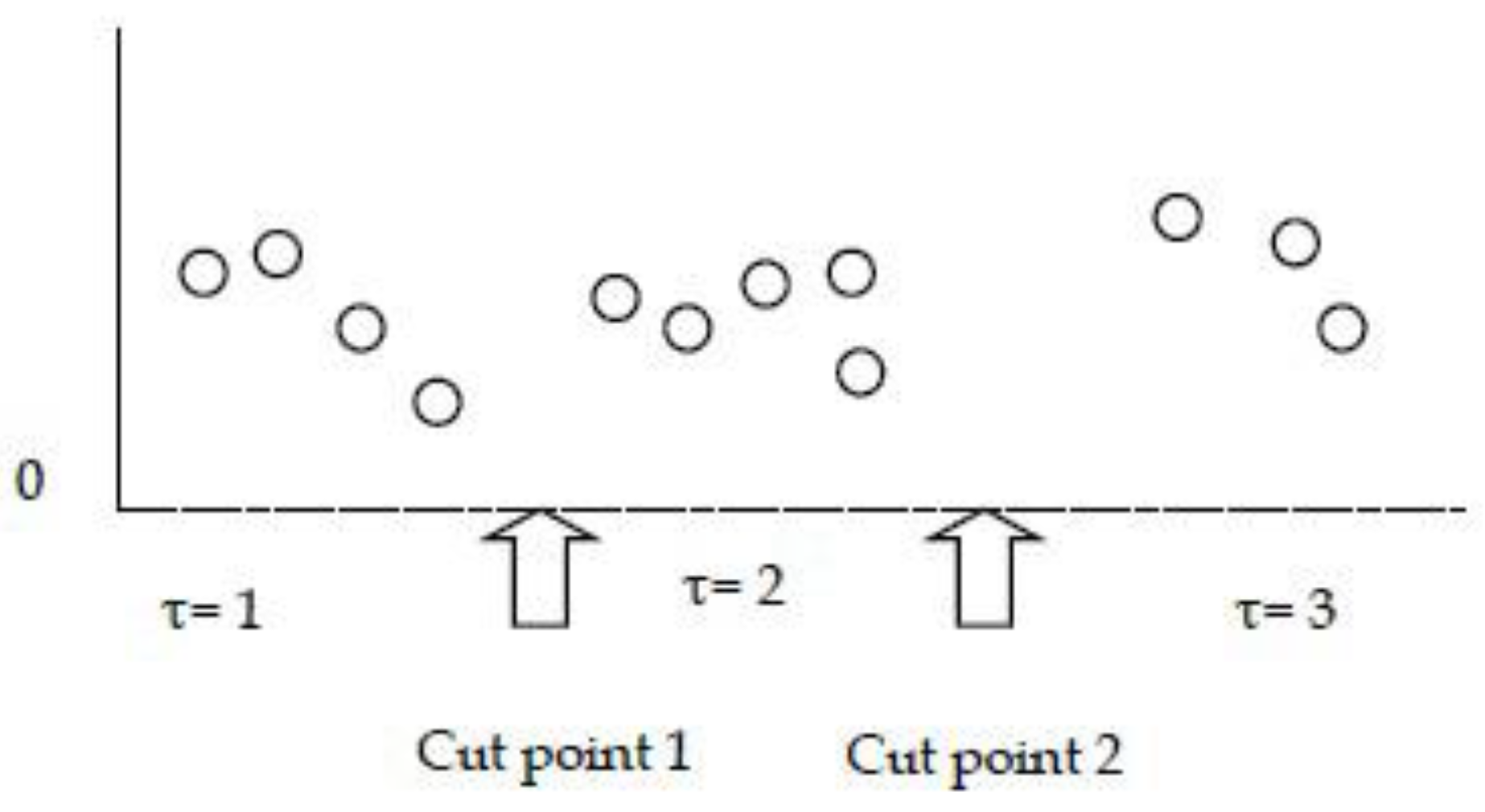
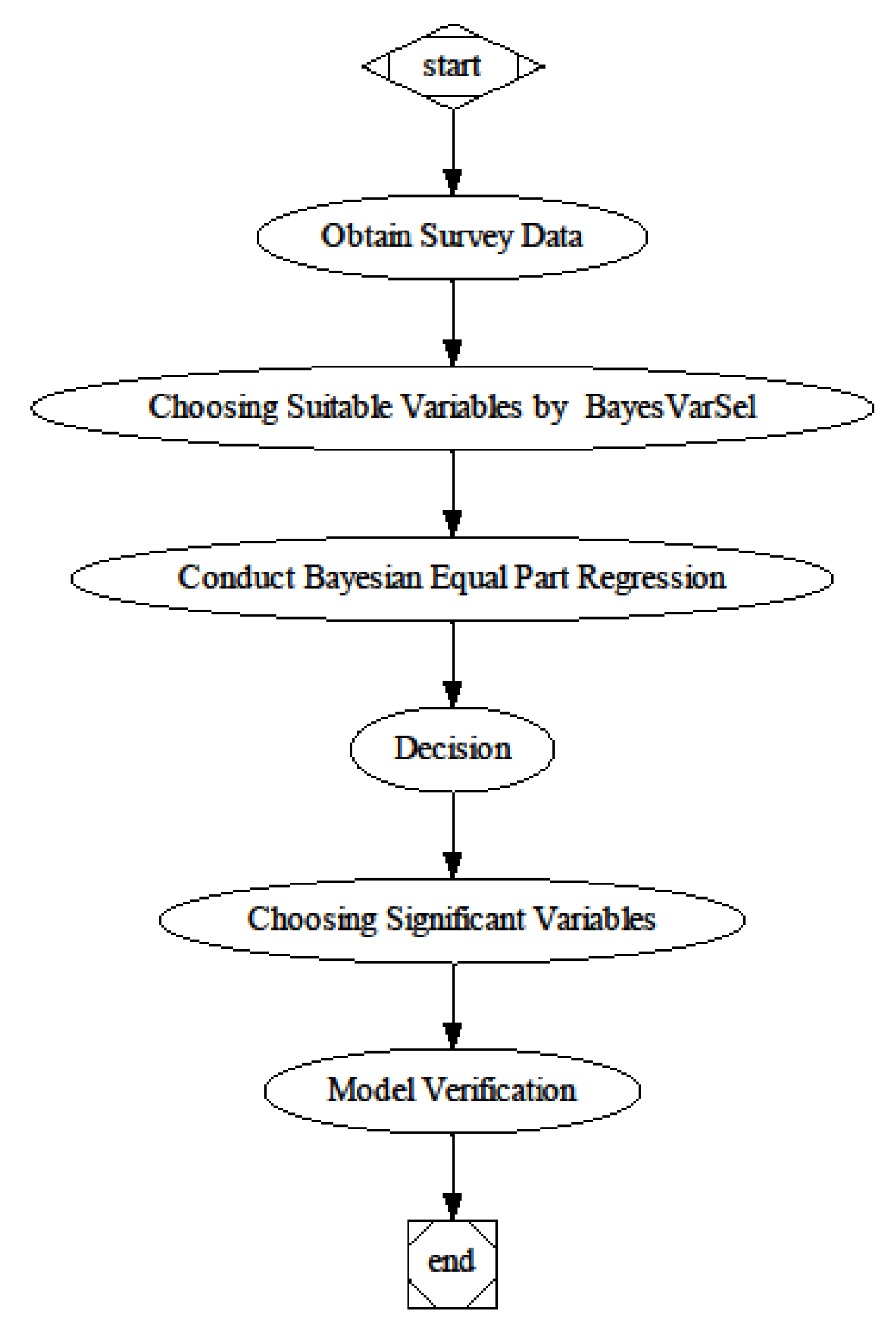

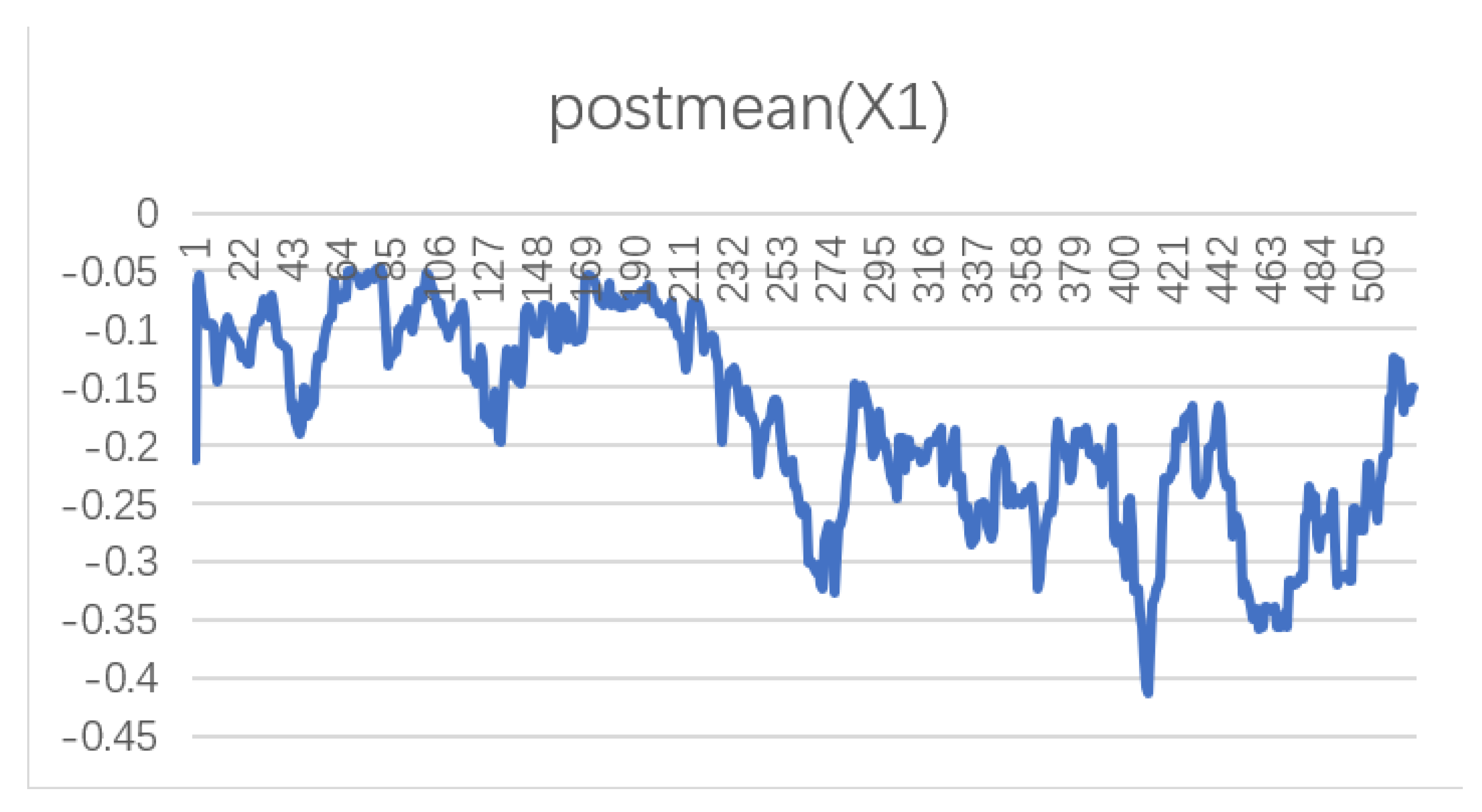
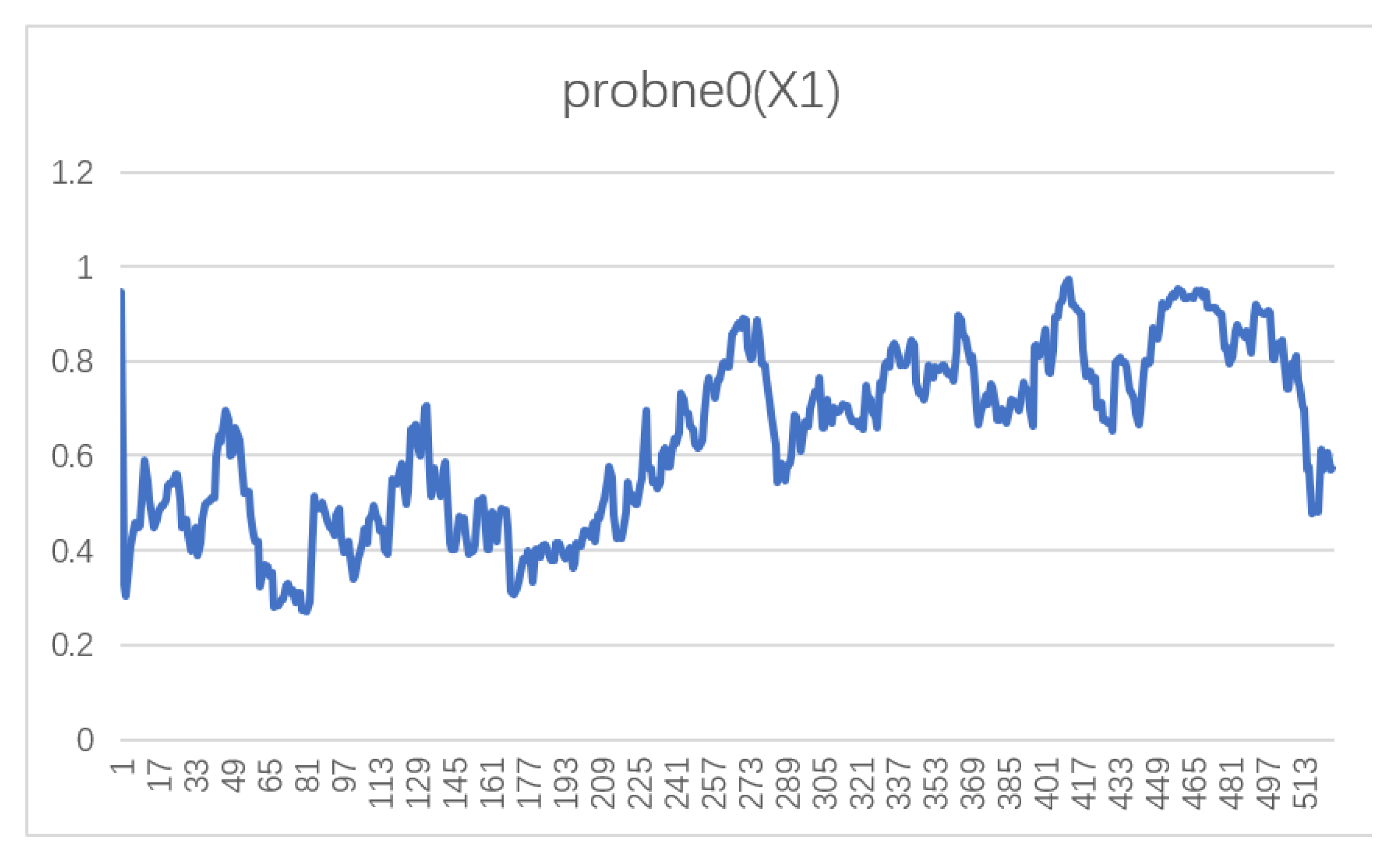

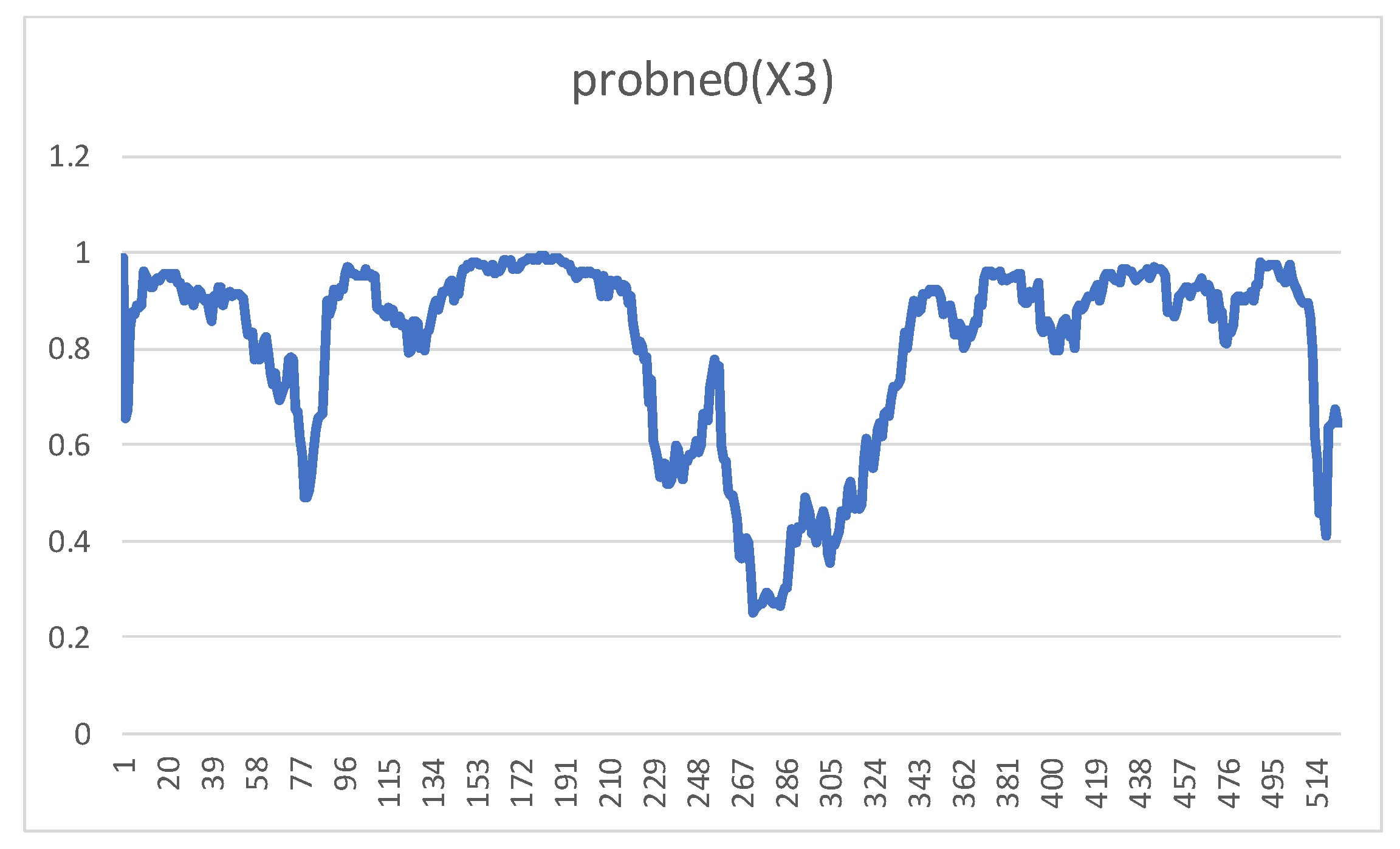

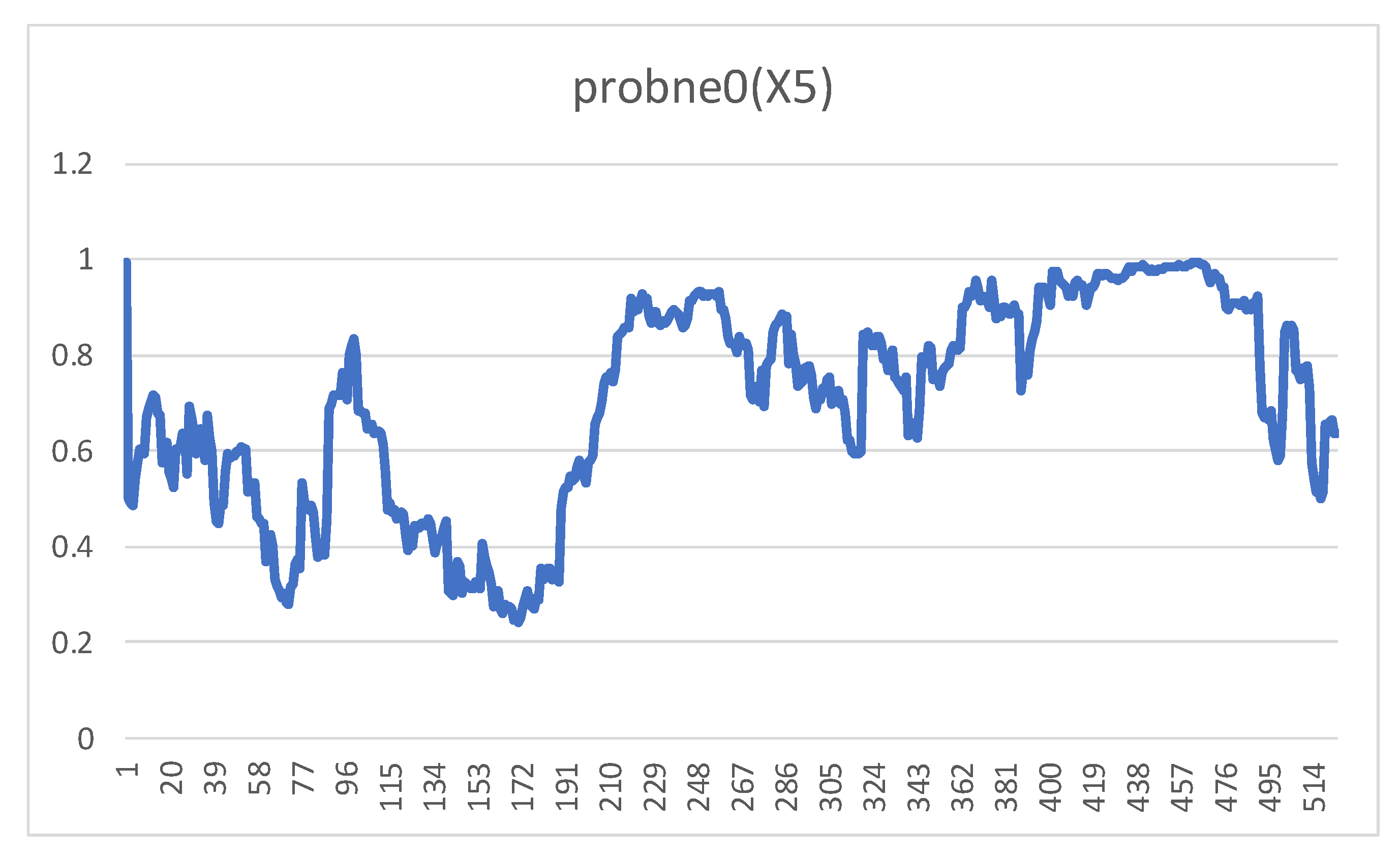
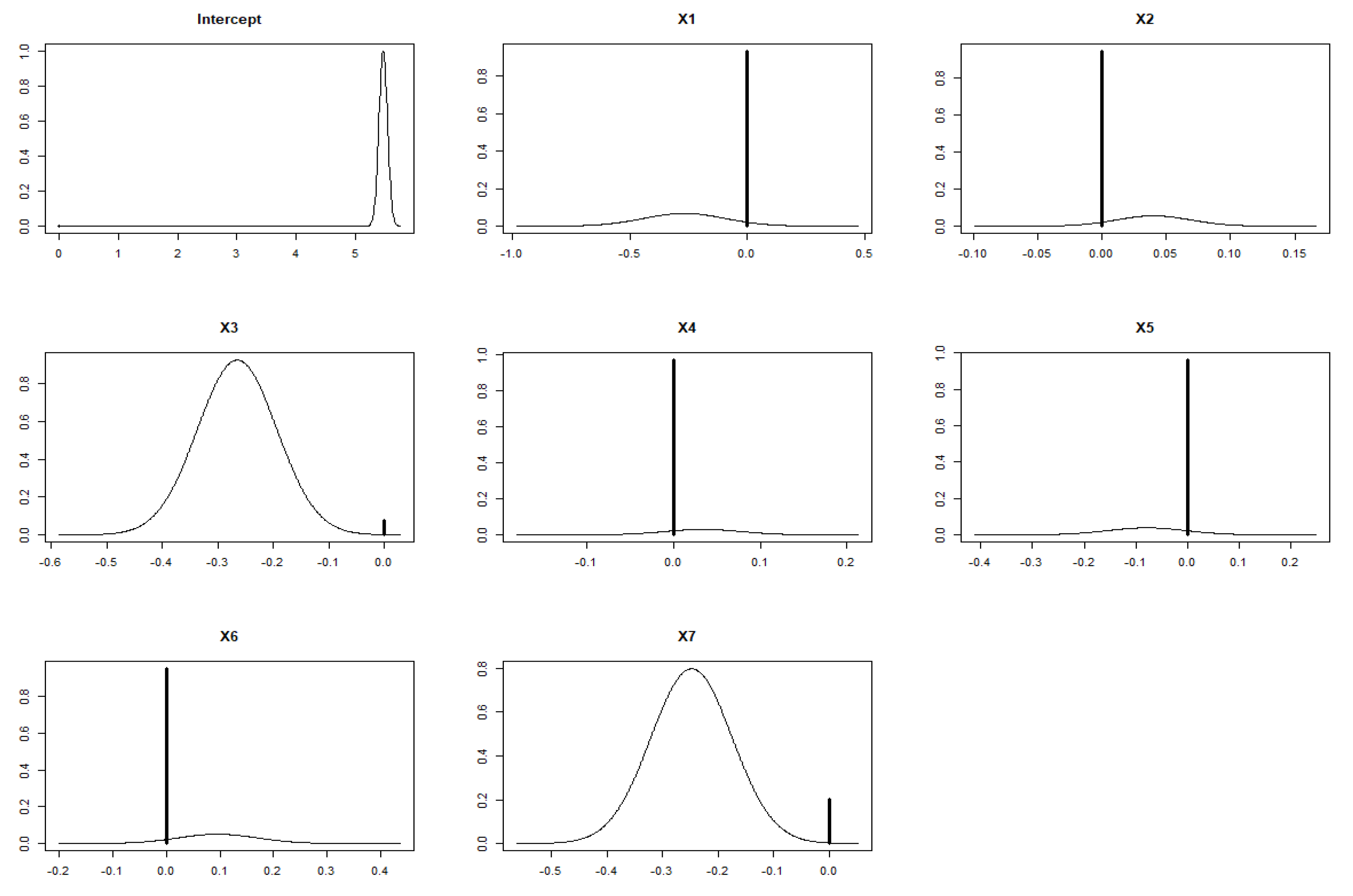
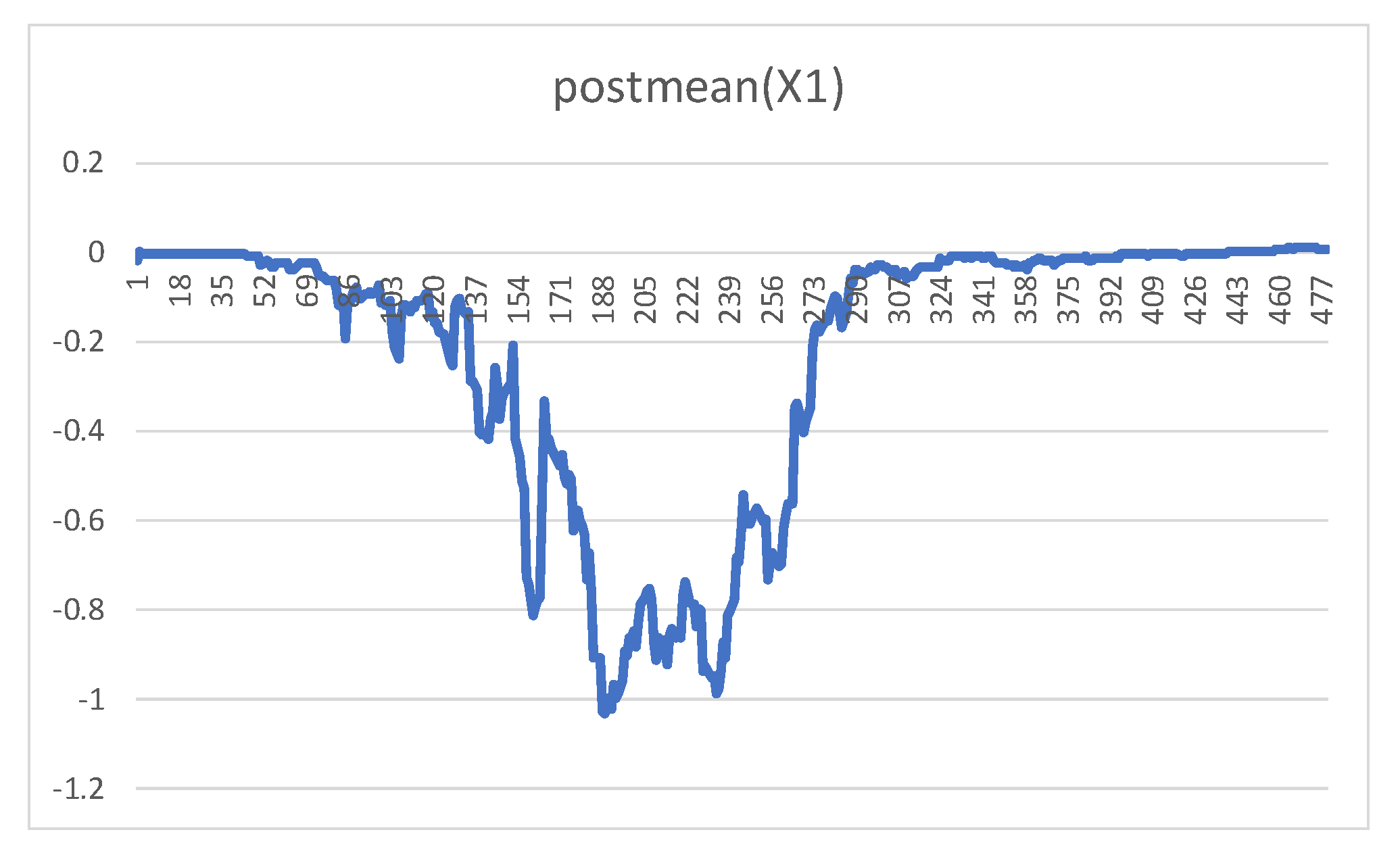
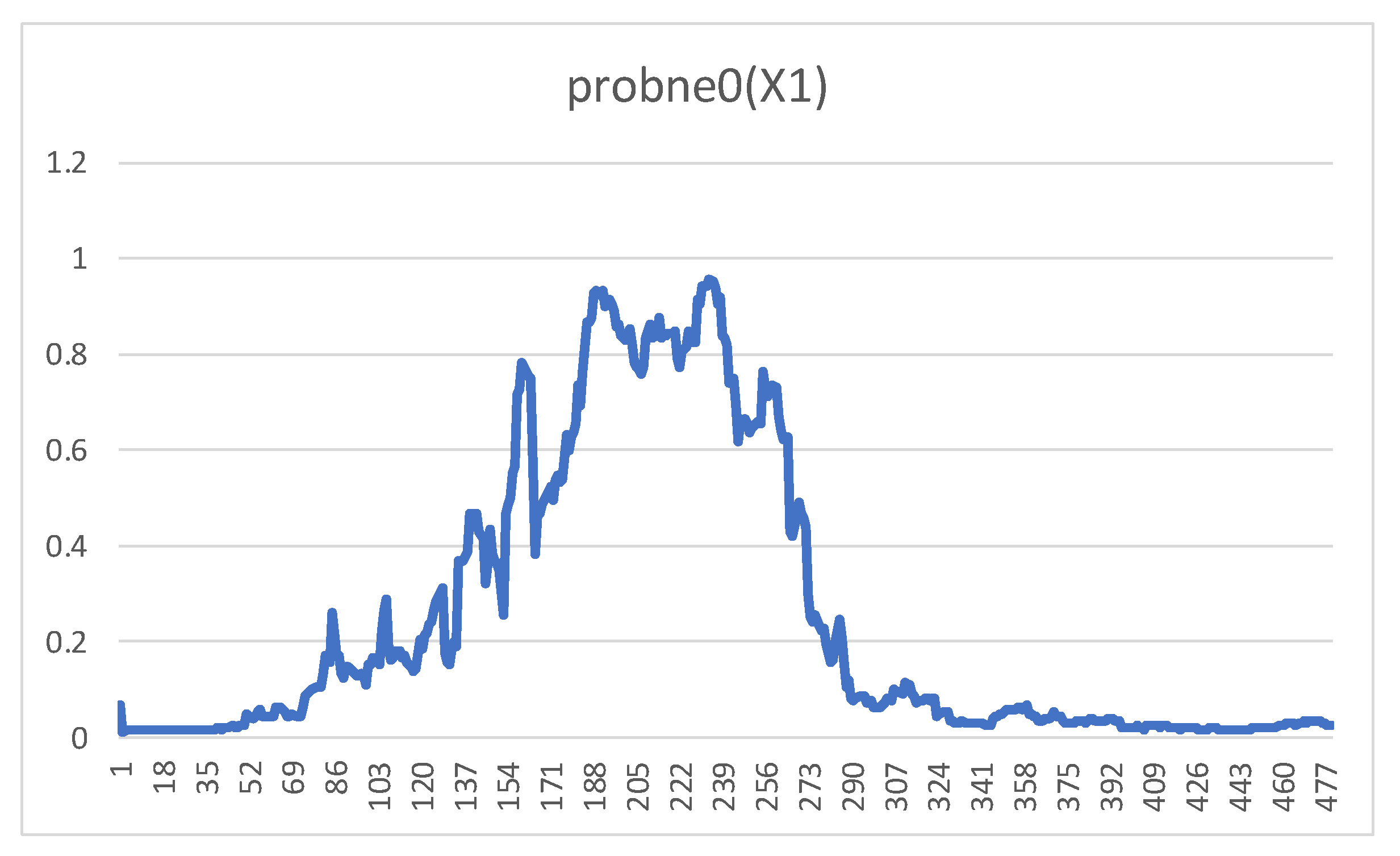




| Variables | nQ4 | nQ9 | nQ13 | nQ16 | nQ18 | nQ25 |
|---|---|---|---|---|---|---|
| Min. | 1.00 | 0.00 | 1.00 | 1.00 | 0.00 | 0.00 |
| Max. | 4.00 | 10.00 | 4.00 | 4.00 | 10.00 | 10.00 |
| Mean | 2.880 | 3.980 | 2.210 | 2.017 | 4.899 | 5.470 |
| Standard Error | 0.960 | 2.214 | 0.989 | 0.911 | 2.633 | 1.645 |
| Variables | nQ6 | nQ8 | nQ18 | nQ21 | nQ25 | nQ27 | nQ29 | nQ31 |
|---|---|---|---|---|---|---|---|---|
| Min. | 1 | 0 | 0 | 1 | 0 | 1 | 1 | 1 |
| Max. | 2 | 10 | 10 | 4 | 10 | 4 | 4 | 4 |
| Mean | 1.22 | 5.471 | 4.963 | 2.683 | 5.479 | 2.912 | 2.899 | 2.994 |
| Standard Error | 0.414 | 1.957 | 2.574 | 1.020 | 1.667 | 0.974 | 0.999 | 0.987 |
| Models | Variables | Post Mean | Post Standard Error | Post Probability of the Non-Zero Coefficient | Credible Intervals (2.5%, 97.5%) |
|---|---|---|---|---|---|
| τ= 1 | constant | 3.839 | 0.116 | 1 | (3.81,4.28) |
| X1 | −0.061 | 0.114 | 0.327 | (0.00,0.00) | |
| X2 | −0.782 | 0.134 | 0.999 | (−0.99,−0.49) | |
| X3 | 0.218 | 0.195 | 0.653 | (0.06,0.62) | |
| X4 | 0.202 | 0.050 | 0.998 | (0.09,0.27) | |
| X5 | 0.07 | 0.093 | 0.501 | (0.008,0.305) | |
| τ = 2 | constant | 4.049 | 0.117 | 1 | (3.81,4.28) |
| X1 | −0.256 | 0.179 | 0.787 | (−0.54,−0.02) | |
| X2 | −0.481 | 0.140 | 0.991 | (−0.70,−0.19) | |
| X3 | 0.110 | 0.152 | 0.471 | (−0.05,0.49) | |
| X4 | 0.318 | 0.051 | 1 | (0.20,0.40) | |
| X5 | 0.160 | 0.102 | 0.818 | (0.03,0.33) | |
| τ = 3 | constant | 4.053 | 0.119 | 1 | (3.82,4.28) |
| X1 | −0.162 | 0.168 | 0.598 | (−0.49,0.01) | |
| X2 | −0.555 | 0.143 | 0.997 | (−0.76,−0.24) | |
| X3 | 0.240 | 0.211 | 0.675 | (0.03,0.62) | |
| X4 | 0.137 | 0.066 | 0.910 | (0.03,0.22) | |
| X5 | 0.102 | 0.097 | 0.636 | (0.007,0.29) |
| Variables | Post Mean | Post Standard Error | Post Probability of the Non-zero Coefficient | Credible Intervals (2.5%, 97.5%) |
|---|---|---|---|---|
| Intercept | 3.98 | 0.067 | 1.000 | (3.85, 4.11) |
| X1 | 0.21 | 0.088 | 0.944 | (−0.34,0.00) |
| X2 | −0.56 | 0.075 | 1.000 | (−0.70,−0.41) |
| X3 | 0.28 | 0.088 | 0.988 | (0.11, 0.45) |
| X4 | 0.20 | 0.024 | 1.000 | (0.15, 0.26) |
| X5 | 0.16 | 0.043 | 0.998 | (0.08, 0.25) |
| Models | Variables | Post Mean | Post Standard Error | Post Probability of the Non-Zero Coefficient | Credible Intervals (2.5%, 97.5%) |
|---|---|---|---|---|---|
| τ = 1 | constant | 5.607 | 0.123 | 1.000 | (5.37,5.85) |
| X1 | 0.000 | 0.036 | 0.013 | (0.00,0.00) | |
| X2 | 0.001 | 0.008 | 0.018 | (0.00,0.00) | |
| X3 | −0.001 | 0.017 | 0.015 | (0.00,0.00) | |
| X4 | −0.001 | 0.011 | 0.015 | (0.00,0.00) | |
| X5 | −0.003 | 0.026 | 0.020 | (0.00,0.00) | |
| X6 | 0.001 | 0.015 | 0.013 | (0.00,0.00) | |
| X7 | −0.065 | 0.140 | 0.204 | (−0.41,0.00) | |
| τ = 2 | constant | 5.343 | 0.125 | 1.000 | (5.09,5.58) |
| X1 | −0.780 | 0.455 | 0.819 | (−1.41,0.00) | |
| X2 | 0.026 | 0.053 | 0.250 | ( 0.00,0.15) | |
| X3 | −0.409 | 0.176 | 0.912 | (−0.64,0.00) | |
| X4 | 0.045 | 0.085 | 0.269 | (0.00,0.24) | |
| X5 | −0.004 | 0.035 | 0.059 | (−0.06,0.00) | |
| X6 | 0.009 | 0.048 | 0.077 | (0.00,0.12) | |
| X7 | −0.010 | 0.050 | 0.080 | (−0.13,0.00) | |
| τ = 3 | constant | 5.473 | 0.126 | 1.000 | (5.21,5.71) |
| X1 | 0.006 | 0.060 | 0.026 | (0.00,0.00) | |
| X2 | −0.001 | 0.009 | 0.024 | (0.00,0.00) | |
| X3 | −0.125 | 0.177 | 0.375 | (−0.47,0.00) | |
| X4 | −0.003 | 0.021 | 0.037 | (0.00,0.00) | |
| X5 | −0.002 | 0.021 | 0.022 | (0.00,0.00) | |
| X6 | 0.005 | 0.036 | 0.036 | (0.00,0.00) | |
| X7 | −0.081 | 0.152 | 0.257 | (−0.47,0.00) |
| Variables | Post Mean | Post Standard Error | Post Probability of the Non-zero Coefficient | Credible Intervals (2.5%, 97.5%) |
|---|---|---|---|---|
| Intercept | 5.47 | 0.07 | 1.000 | (5.33, 5.61) |
| X1 | −0.01 | 0.08 | 0.06 | (−0.16,0.003) |
| X2 | 0.002 | 0.011 | 0.055 | (−0.002, 0.011) |
| X3 | −0.24 | 0.09 | 0.92 | (−0.38, 0.00) |
| X4 | 0.001 | 0.009 | 0.030 | (0.00, 0.00) |
| X5 | −0.003 | 0.021 | 0.038 | (0.00, 0.00) |
| X6 | 0.004 | 0.026 | 0.050 | (0.00, 0.00) |
| X7 | −0.19 | 0.11 | 0.797 | (−0.36, 0.00) |
© 2019 by the author. Licensee MDPI, Basel, Switzerland. This article is an open access article distributed under the terms and conditions of the Creative Commons Attribution (CC BY) license (http://creativecommons.org/licenses/by/4.0/).
Share and Cite
Wu, S. A Bayesian Equal Part Regression Analysis of the Influencing Factors of Taiwanese People’s Regime Acceptance of Mainland China and U.S. Governments. Mathematics 2019, 7, 504. https://doi.org/10.3390/math7060504
Wu S. A Bayesian Equal Part Regression Analysis of the Influencing Factors of Taiwanese People’s Regime Acceptance of Mainland China and U.S. Governments. Mathematics. 2019; 7(6):504. https://doi.org/10.3390/math7060504
Chicago/Turabian StyleWu, Shianghau. 2019. "A Bayesian Equal Part Regression Analysis of the Influencing Factors of Taiwanese People’s Regime Acceptance of Mainland China and U.S. Governments" Mathematics 7, no. 6: 504. https://doi.org/10.3390/math7060504
APA StyleWu, S. (2019). A Bayesian Equal Part Regression Analysis of the Influencing Factors of Taiwanese People’s Regime Acceptance of Mainland China and U.S. Governments. Mathematics, 7(6), 504. https://doi.org/10.3390/math7060504





